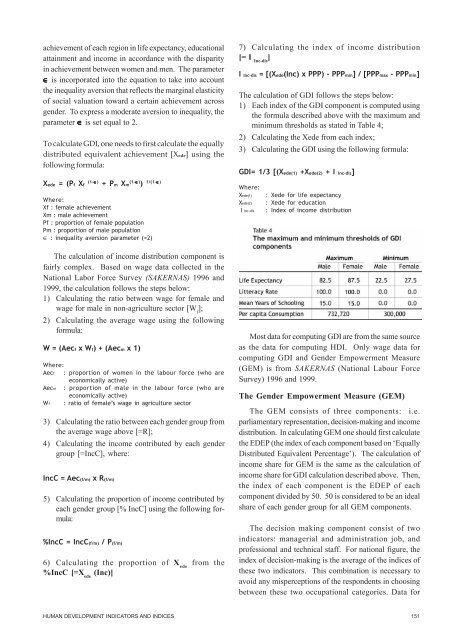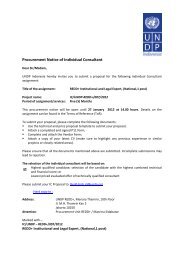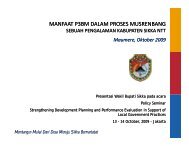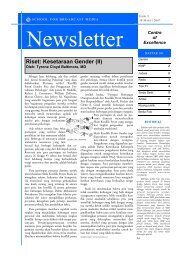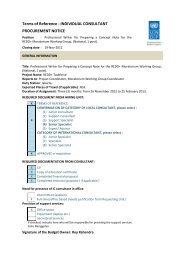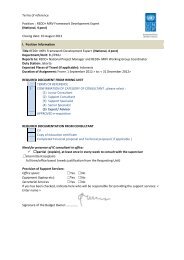Indonesia Human Development Report 2001 - UNDP
Indonesia Human Development Report 2001 - UNDP
Indonesia Human Development Report 2001 - UNDP
Create successful ePaper yourself
Turn your PDF publications into a flip-book with our unique Google optimized e-Paper software.
achievement of each region in life expectancy, educationalattainment and income in accordance with the disparityin achievement between women and men. The parameter∈ is incorporated into the equation to take into accountthe inequality aversion that reflects the marginal elasticityof social valuation toward a certain achievement acrossgender. To express a moderate aversion to inequality, theparameter ∈ is set equal to 2.To calculate GDI, one needs to first calculate the equallydistributed equivalent achievement [Xede] using thefollowing formula:Xede = (Pf Xf (1-∈) + Pm Xm (1-∈ ) ) 1/(1-∈)Where:Xf : female achievementXm : male achievementPf : proportion of female populationPm : proportion of male population∈ : inequality aversion parameter (=2)The calculation of income distribution component isfairly complex. Based on wage data collected in theNational Labor Force Survey (SAKERNAS) 1996 and1999, the calculation follows the steps below:1) Calculating the ratio between wage for female andwage for male in non-agriculture sector [W f];2) Calculating the average wage using the followingformula:W = (Aecf x Wf) + (Aecm x 1)Where:Aecf : proportion of women in the labour force (who areeconomically active)Aecm : proportion of male in the labour force (who areeconomically active)Wf : ratio of female’s wage in agriculture sector3) Calculating the ratio between each gender group fromthe average wage above [=R];4) Calculating the income contributed by each gendergroup [=IncC], where:IncC = Aec(f/m) x R(f/m)5) Calculating the proportion of income contributed byeach gender group [% IncC] using the following formula:%IncC = IncC(f/m) / P(f/m)6) Calculating the proportion of X edefrom the%IncC [=X ede(Inc)]7) Calculating the index of income distribution[= I Inc-dis]I Inc-dis = [(Xede(Inc) x PPP) - PPPmin] / [PPPmax - PPPmin]The calculation of GDI follows the steps below:1) Each index of the GDI component is computed usingthe formula described above with the maximum andminimum thresholds as stated in Table 4;2) Calculating the Xede from each index;3) Calculating the GDI using the following formula:GDI= 1/3 [(Xede(1) +Xede(2) + I Inc-dis]Where:Xede(1)Xede(2)I Inc-dis: Xede for life expectancy: Xede for education: Index of income distributionMost data for computing GDI are from the same sourceas the data for computing HDI. Only wage data forcomputing GDI and Gender Empowerment Measure(GEM) is from SAKERNAS (National Labour ForceSurvey) 1996 and 1999.The Gender Empowerment Measure (GEM)The GEM consists of three components: i.e.parliamentary representation, decision-making and incomedistribution. In calculating GEM one should first calculatethe EDEP (the index of each component based on ‘EquallyDistributed Equivalent Percentage’). The calculation ofincome share for GEM is the same as the calculation ofincome share for GDI calculation described above. Then,the index of each component is the EDEP of eachcomponent divided by 50. 50 is considered to be an idealshare of each gender group for all GEM components.The decision making component consist of twoindicators: managerial and administration job, andprofessional and technical staff. For national figure, theindex of decision-making is the average of the indices ofthese two indicators. This combination is necessary toavoid any misperceptions of the respondents in choosingbetween these two occupational categories. Data forHUMAN DEVELOPMENT INDICATORS AND INDICES151


